Source: Veritas Prep
If 320 people attended the wedding and 200 attendees drank wine, how many attendees drank neither beer nor wine?
1. There was the same number of beer drinkers as nondrinkers.
2. The same number of people drank only beer as drank both beer and wine.
The OA is C
If 320 people attended the wedding and 200 attendees drank
This topic has expert replies
-
BTGmoderatorLU
- Moderator
- Posts: 2207
- Joined: Sun Oct 15, 2017 1:50 pm
- Followed by:6 members
Timer
00:00
Your Answer
A
B
C
D
E
Global Stats
GMAT/MBA Expert
- Brent@GMATPrepNow
- GMAT Instructor
- Posts: 16207
- Joined: Mon Dec 08, 2008 6:26 pm
- Location: Vancouver, BC
- Thanked: 5254 times
- Followed by:1268 members
- GMAT Score:770
Timer
00:00
Your Answer
A
B
C
D
E
Global Stats
This question is somewhat ambiguous, since it's hard to say whether "nondrinkers" in statement 1 refers to people who drank neither beer nor wine, or did not drink beer. I'm assuming that it means to not drink beer, so I've add that to the question below.BTGmoderatorLU wrote:Source: Veritas Prep
If 320 people attended the wedding and 200 attendees drank wine, how many attendees drank neither beer nor wine?
1. There was the same number of beer drinkers as nondrinkers.
2. The same number of people drank only beer as drank both beer and wine.
The OA is C
One approach is to use the Double Matrix Method. This technique can be used for most questions featuring a population in which each member has two characteristics associated with it.At a certain wedding, the bar served only beer and wine. If 320 people attended the wedding, and 200 attendees drank wine, how many attendees drank neither beer nor wine?
(1) There were the same number of beer drinkers as non-[beer]-drinkers.
(2) The same number of people drank only beer as drank both beer and wine.
Here, we have a population of wedding attendees, and the two characteristics are:
- drank beer or didn't drink beer
- drank wine or didn't drink wine
Given: 320 people attended the wedding, and 200 attendees drank wine
This means that 120 people did NOT drink wine.
So, we can set up our matrix as follows:
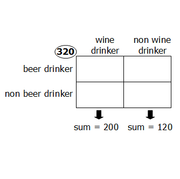
Target question: How many attendees drank neither beer nor wine?
We'll add a star in the box denoting neither beer nor wine, to remind that this is the GOAL of the target question.
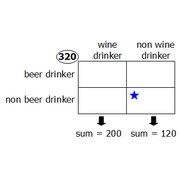
Statement 1: There were the same number of beer drinkers as non-beer-drinkers.
So, of the 320 attendees, 160 drank beer and 160 did not drink beer.
When we add this information to the diagram, we get the following:
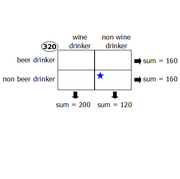
As you can see, we still don't have enough information to determine the value in the starred box.
Since we cannot answer the target question with certainty, statement 1 is NOT SUFFICIENT
Statement 2:The same number of people drank only beer as drank both beer and wine.
Let x = # of people who drank only beer (i.e., drank beer but not wine)
So, x also equals # of people who drank both beer and wine
hen we add this information to the diagram, we get the following:
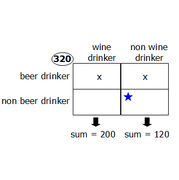
As you can see, we still don't have enough information to determine the value in the starred box.
Since we cannot answer the target question with certainty, statement 2 is NOT SUFFICIENT
Statements 1 and 2 combined
When we combine both statements, we get the following:
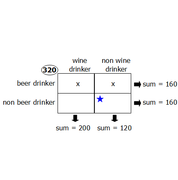
If we examine the top row, we see that we can create the equation x + x = 160
So, x = 80
Add this information to the diagram to get:
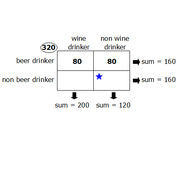
From here, we can see that, since the two boxes in the right-hand column must add to 120, the value in the starred box must equal 40:
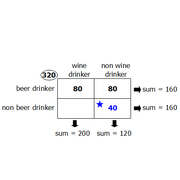
So, 40 people drank neither beer nor wine.
Since we can answer the target question with certainty, the combined statements are SUFFICIENT
Answer = C
Cheers,
Brent
-------------------------------------------
To learn more about the Double Matrix Method, watch our free video: https://www.gmatprepnow.com/module/gmat- ... ems?id=919
Once you're familiar with the technique, you can attempt these additional practice questions:
Easy Problem Solving questions
- https://www.beatthegmat.com/the-aam-aadm ... 72242.html
- https://www.beatthegmat.com/finance-majo ... 67425.html
Medium Problem Solving questions
- https://www.beatthegmat.com/probability- ... 73360.html
- https://www.beatthegmat.com/posted-speed ... 72374.html
- https://www.beatthegmat.com/motel-t271938.html
- https://www.beatthegmat.com/of-the-appli ... 70255.html
- https://www.beatthegmat.com/opening-nigh ... 64869.html
- https://www.beatthegmat.com/ds-french-ja ... 22297.html
Difficult Problem Solving questions
- https://www.beatthegmat.com/ratio-problem-t268339.html
- https://www.beatthegmat.com/overlapping- ... 65223.html
- https://www.beatthegmat.com/fractions-t264254.html
- https://www.beatthegmat.com/overlapping- ... 64092.html
- https://www.beatthegmat.com/mba/2011/05/ ... question-2
Easy Data Sufficiency questions
- https://www.beatthegmat.com/for-what-per ... 70596.html
- https://www.beatthegmat.com/ds-quest-t187706.html
Medium Data Sufficiency questions
- https://www.beatthegmat.com/sets-matrix-ds-t271914.html
- https://www.beatthegmat.com/each-of-peop ... 71375.html
- https://www.beatthegmat.com/a-manufacturer-t270331.html
- https://www.beatthegmat.com/in-costume-f ... 69355.html
- https://www.beatthegmat.com/mba/2011/05/ ... question-1
Difficult Data Sufficiency questions
- https://www.beatthegmat.com/double-set-m ... 71423.html
- https://www.beatthegmat.com/sets-t269449.html
- https://www.beatthegmat.com/mba/2011/05/16/random-dou




















